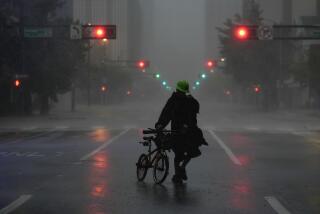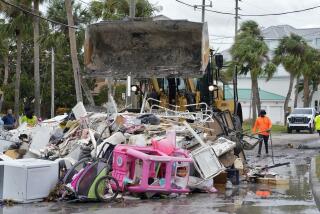Hurricane catches Texas by surprise
HOUSTON — Texans went to bed Wednesday night expecting to be struck by a tropical storm. They awoke to find they’d been hit by a hurricane instead.
The stunningly fast buildup of what became Hurricane Humberto shocked scientists, some of whom said there was nothing like it on record.
In just 18 hours, Humberto strengthened from a tropical depression with maximum sustained winds of 35 mph to a Category 1 hurricane with 85-mph winds before crashing ashore. It did not grow into a hurricane until after midnight.
“That has never before happened” in the more than 150 years that scientists have been tracking hurricanes, said James Franklin, a senior specialist at the National Hurricane Center in Miami.
“It’s very, very rare to see a storm go from a depression to a hurricane in this short a time,” he said. “It’s only happened four times before since 1851, and this is the only one to do this just before landfall.”
Humberto came ashore near the East Texas cities of Beaumont and Port Arthur around 2 a.m. Thursday, according to the National Hurricane Center. It was a compact storm, with hurricane-force winds extending just 15 miles from its center.
It shook up parts of Texas, drenching an already soaked region, shutting down three oil refineries, knocking out power to about 112,000 customers and killing an 80-year-old man.
Much of the damage occurred in High Island, a community of 500 people about five miles west of where Humberto came ashore. The roof of a convenience store was ripped off, the post office was damaged, and a scoreboard and spotlights at the High Island High School football stadium were torn to pieces.
Forecasters initially predicted Humberto would hit farther west, near Galveston. Franklin said Thursday that the storm’s more easterly course caused it to stay in the hot waters of the Gulf of Mexico a little longer, where it gained intensity.
“This took everyone by surprise. This just wasn’t forecasted to be this bad,” said Sgt. Ken Carona of the Port Arthur Police Department. “We knew we were going to get heavy rains, but we did not expect hurricane-strength winds at all.”
Carona said Port Arthur sustained some minor wind damage to homes and businesses. The biggest problem, he said Thursday, was a lack of electricity.
Entergy Texas, the utility for the region, said electricity was slowly being restored, but that some customers may be without power for days.
Humberto, which struck about 50 miles from the spot where Hurricane Rita came ashore two years ago, quickly moved east into Louisiana and weakened into a tropical storm. By Thursday night, it was a tropical depression.
But the storm was expected to drop up to 8 inches of rain before it passed, which led local and state officials to worry that the region, still recovering from Rita, would suffer serious flooding damage. Mississippi and Alabama also were expected to receive heavy rains.
It is rare for a hurricane to initiate in the Gulf of Mexico, as Humberto did. Many form off the coast of Africa and travel across the Atlantic for days, gaining size and strength before reaching the Americas.
Kerry Emanuel, a meteorology professor at MIT, said that although Humberto’s suddenness was unusual, it may not be as rare as some believe. He noted that because tropical storms tend to form far offshore, they’re not studied as closely during their initial hours.
William Gray, a professor emeritus at Colorado State University who is considered one of the fathers of hurricane forecasting, agreed.
“The truth,” Gray said, “is that even with all the technological advances we’ve made, we still have trouble forecasting the intensification of these things.”
--
More to Read
Sign up for Essential California
The most important California stories and recommendations in your inbox every morning.
You may occasionally receive promotional content from the Los Angeles Times.









